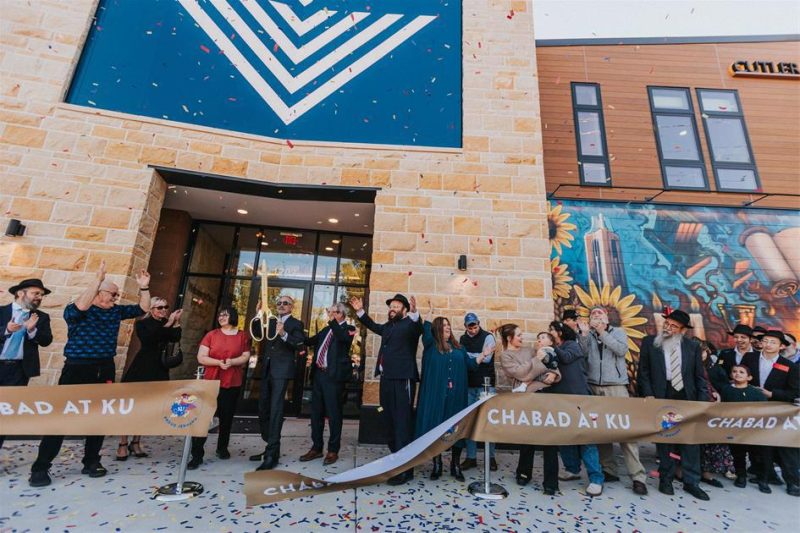
In the Heart of Kansas, Chabad of KU Opens Stunning New Center
by Shloimy Galperin – chabad.org
Some 450 people danced in the streets of Lawrence, Kan., in early November, celebrating the newly opened Chabad-Lubavitch Center for Jewish Life at Kansas University. Spanning 10,000 square feet and costing $6 million, the modern, art-covered Chabad of KU, is the first building constructed for Jewish students in the state’s history.
“The college chancellor closed down the streets so we could dance through them for the grand opening,” remarked Shai Luger, a Jewish student at KU and member of Chabad’s leadership board. “The second floor is basically a hotel, which we call the ‘Challa-day Inn.’ It has 24 beds, restrooms and showers, and a full kosher kitchen.”
Like all stories of great success, Chabad of KU had humble beginnings. In March of 2006, Rabbi Zalman and Nechama Tiechtel moved to Lawrence to serve as emissaries of the Rebbe, Rabbi Menachem M. Schneerson, of righteous memory. The couple and their six-week-old baby moved into one side of a rented duplex, a stone’s throw from the Kansas University campus. There they were, in the middle of Midwest America, ready to serve both KU’s 1,500 Jewish students and the local community.

“My wife and I grew up with a shlichut mindset, ready to serve a Jewish community,” relates Tiechtel. “Before we made the move, we met with Rabbi Sholom Ber Wineberg, director of Chabad of Kansas, to learn about our prospective post, 40 miles west of Kansas City. We were told of the great potential for growth at KU, and it sounded promising. But more than data and advice, we wanted direction.”
The young couple flew back to New York, heading straight to the Ohel, the resting place of the Rebbe in Queens, upon their return. The rabbi remembered praying to G‑d for a sign that Kansas was the place for them. Later that day, as Tiechtel was going through his mailbox throwing out the catalogs and advertisement papers that had accumulated during their time in Kansas, a return address on an envelope in the junk pile caught his attention.
“It was posted from Lawrence, Kansas,” he recalls. “It felt like it was meant to be.”
Just four students joined the Tiechtels for their first Friday-night Shabbat meal. But the work had begun.
The Jewish Response to Antisemitism
Slowly, their numbers began to swell. Tiechtel recalls looking around their dining room on a Friday evening a few years later.
“The place was packed. It was the most sign-ups for Shabbat dinner we ever got,” recalls the rabbi. “Last-minute reservations from students, some of which have never come to our home before, kept on coming in.”
Earlier that week, there had been an incident on campus. It began in the heart of the quad, the spot everyone jokingly called Wescoe Beach. Two students raised themselves on a platform in the middle of the campus quad and shouted racial and antisemitic slurs over megaphones. Some students argued with them, some just watched, and a small circle of Jewish students stood together, quiet but firm. Others began surrounding the Jewish students, forming a sort of protective barrier. One Jewish student, a freshman named Charles Goldberg, did something extraordinary. He put on his tallit and began to pray.
By evening, the photo of Goldberg wrapped in his tallit was on the front page of the campus paper, captioned: “The Jewish Response.”
Goldberg would later marry in Israel, with Rabbi Tiechtel standing under his chuppah. But that moment on Wescoe Beach—when a freshman stood tall against hate—had set the stage.
By the time Oct. 7 took place, bringing in its aftermath waves of anti-Jewish hate, especially on campus, KU’s Jewish students knew they had an alternative playbook to pull from. Instead of cowering, they would be even more proudly Jewish. On the first anniversary of the Oct. 7 attack, Jewish students involved with Chabad set up a stand on campus with the message ‘“spread cream cheese on bagels, not hate.”’ The students handed out those bagels (of course) together with QR codes that informed the reader about the hostages and other unfolding events in the Land of Israel.
“One rather distasteful fellow cursed at us,” shared Josh Glen, a student at KU and regular at the Chabad center. “But overall, the atmosphere on campus is peaceful, and I feel safe and proud to be a Jew openly.”
That sense of Jewish pride shows up in everyday moments. At the football stadium, students line up for kosher hot dogs—the first kosher food stand on any campus in the country—while the Jayhawk, the college mascot, breaks into a dance alongside the Jewhawk, Chabad’s own spirited symbol.

Building in the Face of Tragedy
Although the Chabad of KU family grew, the small duplex out of which the Tiechtels ran their entire Chabad center, did not.
The Tiechtels made multiple offers to buy the property, but the landlord wasn’t interested. That is, until one day in 2008. Rabbi Tiechtel had gone to New York to pray at the Ohel for success in expanding the Chabad center. Sitting in his car afterwards, he received an unexpected phone call from the landlord. On the spot, he agreed to sell the property without giving any reason. “An open miracle,” said Tiechtel, whom students have come to call “the Miracle Worker” for the many miraculous things that seem to happen at Chabad of KU on a regular basis. (Rabbi Tiechtel repeatedly reminds them that it is G‑d who performs the miracles).
Eventually, the duplex proved to be too small, and in 2010, the Chabad center underwent renovations. In 2015, the Tiechtels converted their garage into a student lounge to accommodate the growing student family. Less than a decade later, the Chabad center needed yet another expansion, only this time the building story was bittersweet.
The Tiechtels were at the point where they had to erect an 80-foot tent in their backyard to accommodate everyone. Beautiful events were held under ferry lights draped along the tall white walls of the tent. But more space was needed. They put in an offer for the property adjacent to theirs, but in this case, too, the neighbor wasn’t interested. Months went by, and the Tiechtels tried again, but the owner refused.
One day, tragedy struck. A student in the campus community had taken their own life. When the neighboring owner heard the sad news, he told Tiechtel he changed his mind. The Chabad center’s vital role caring for the mental, physical and spiritual health of KU students was too important to keep limit.
With both properties, the original duplex and the adjacent home, there was enough land to build something entirely new. The Tiechtels went to the drawing board to design their new building.
On a bright Sunday morning on Nov. 2, Chabad of KU hosted the grand opening of its long-awaited state-of-the-art building.
At the entrance to the new center stands a towering menorah, capable of glowing in 15 different colors, to brighten the darkest nights. Spanning the building’s front is a striking 50-foot mural by internationally acclaimed artist Solomon Souza, best known for his 250 painted shutters in Jerusalem’s Machane Yehuda open-air market and iconic mural of Rabbi Schneur Zalman of Liadi, the founder of Chabad known as the Alter Rebbe, in Brooklyn, N.Y.
“The new building changed everything,” Tiechtel related. “Students used to come to Chabad for programs and events and then leave; there really wasn’t the space to just hang around. Now that we’ve built them a big enough home, they stay.”

It’s not just inside, either. The new center’s beautiful outdoor space includes a Serenity Garden featuring a fire pit dotted with cozy lawn chairs for use during warmer weather. A fountain flows around the patio surrounded by tall, fresh maples. Tiechtel says it’s not unusual for students to unwind around the firepits until the early morning hours.
“Anybody who wants to get away from the college hustle and bustle can sneak away to the Neshama Lounge,” shared Josh Glen, a student at KU and regular at Chabad, about another feature at the new center. “You can swing on the built-in swing, listen to the calming trickle of the indoor fountain, and have peace of mind. It’s a safe space to get away from all the noise.”
Together with the physical space created to ensure the students have optimum mental health, Chabad of KU has a variety of mental-health programs. Once a semester, they even have a mental-health retreat, where students are joined by the Tiechtels on a ranch and have various workshops. One example is a peer support workshop, where clinical professionals are invited to give each student the tools to be there for someone undergoing mental or emotional distress. Not to mention the weekly chicken soup deliveries the Tiechtels and student volunteers prepare and distribute.

Now, a massive institution with more than 50 programs, classes and retreats, with regular participation of some 600 students, Chabad of KU remains a family. Themed Shabbat dinners, holiday celebrations, JewishU classes, Sinai scholars, Lunch ‘n Learn, social events like sushi night and barbecues, are only some of the programs organized by Chabad of KU.
“On some weekdays, we all sit down and have dinner together,” shared Mendel Moulley, a rabbinic intern on Campus.“It’s a great time to talk about the day and just farbreng about Judaism. Everyone who comes to Chabad of KU is individually catered to, and is always seen and heard.”
“I’ve never met anyone more caring than the Tiechtels,” said Aidan Charlip, an alumna at KU who was moved to spend a summer in yeshivah, and flew from New York to Kansas for the grand opening. “They cut out a piece of their heart and give it to anyone who walks through the doors of the Chabad center. It doesn’t matter how often they come, whether it’s daily, weekly or once a year on the High Holidays; the Tiechtels are genuinely there for them.”













